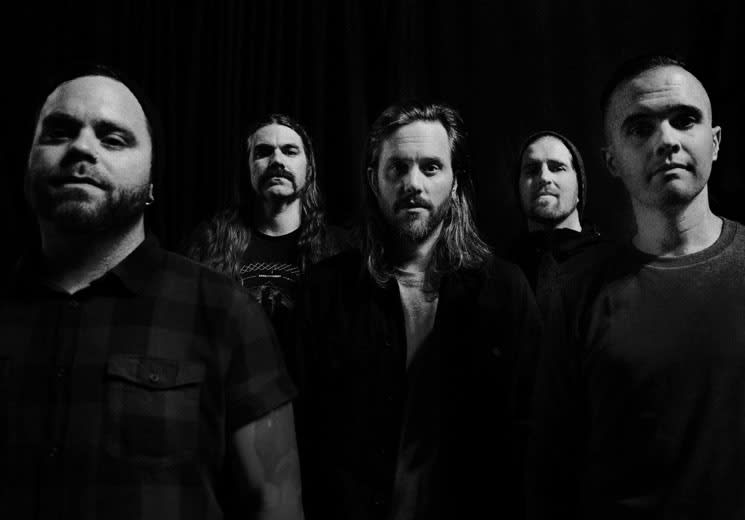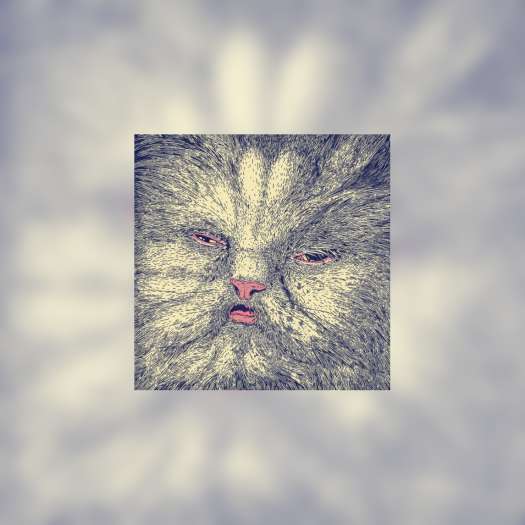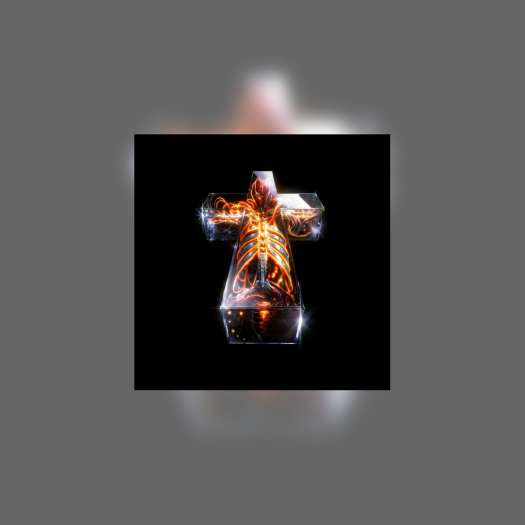Between the Buried and Me aren't content doing the same thing twice. The progressive metal act built their sound through death metal and metalcore, but have since experimented with a vast range of genres, included an ensemble of classical musicians on The Parallax II: Future Sequence, and almost entirely ditched their death metal side for their last album, Coma Ecliptic. Now, the band have returned with their heavier sound in tow for a two-part concept album: Automata I, and this week's conclusion, Automata II.
Despite many fans thinking Between the Buried And Me were headed in a rock-oriented direction after the release of Coma Ecliptic, vocalist and keyboardist Tommy Rogers says the band decided to create something a bit heavier after drastically shifting their sound.
"We like trying things and I think Coma is a really important record for us, because it was very different," Rogers tells Exclaim! "I think some people were scared that that was what we were going to be from now on, which I think we've proven that we're not ever going to be one thing. We just like to constantly be new things."
One of the most noticeable changes in the band's sound that had some fans worried with Coma Ecliptic was the lack of death metal-style vocals. Rogers explains the direction the music was going in for that record gravitated towards a more melodic sound than with Automata, and pushed him to test out new vocal melodies.
"There weren't many opportunities that called for anything like that. The music was different, and I wanted to try new things with my voice and complement it in a different way. With the newer stuff, there were just more moments where I thought 'This needs to be really pissed,'" says Rogers.
While the band's sound is instantly recognizable, Between the Buried and Me almost never stick to a single genre, and often change their sound at seemingly random moments. They've experimented with everything from jazz, bluegrass, arena rock, polka, opera and more, but as Rogers explains, each influence they use is intertwined with one another.
"Normally, the stuff that's off-the-wall is something different, it's based off of something that happened before in the song, whether it's a melody that hints at something in the song. There's a reason for everything but for us anytime we try or do different, I guess genre jumping, we just want it to be cohesive and fit the song and I think it's something that I think we've done really good with over the years," says Rogers.
During the recording process for Automata, the band noted that the album had a clean middle point where they could separate it into two records. After discussing the logistics of how they could pull it off without negatively affecting the release, the band decided to try something new by releasing the two-part album at separate dates — part one was released in March and part two drops this week.
"In 2018, everybody gets everything instantly, right when they want it, and there's something kind of nice about not getting everything at once. We hoped that it would help the second half get some more exposure than it would normally, because our music is so long, not every fan is going to sit down and dive through the whole record," says Rogers.
The band's main concern with releasing the record this way was having both parts sound cohesive on their own, since they were recorded as a single unit. After discussing the idea, the band felt both parts could stand as full records, and that the first part teased the second enough to make it worthwhile to split them.
"I think it works well. I don't think it's something like 'This is how we're going to release records from now on.' Just like anything in our music, we just wanted to try something new and see what happens. It's a very Between the Buried and Me thing to do," says Rogers.
Another noticeable change made on Automata is how the story behind the concept was written. Rogers says he typically creates timelines for events in the plot of the album, but instead decided to write as he went. Writing in this way led to the vocalist changing the outcome of the storyline from what he had been doing for years.
"It kind of worked out that it went in that direction, because I kind of made the story have a lighter note at the end and a positive ending, which has never happened with us," says Rogers. "When we write these concept records, it always changes moods and this one went in that direction."
The album's concept is rooted in the idea of people's dreams being broadcast to the world as a form of entertainment. Rogers says he has a fascination with the idea of dreaming and wanted to explore the topic again after Coma Ecliptic, but he wanted to write something he could relate to on a personal level.
"When I started the album — not that concept records were bothering me, I just wanted to find more personal connection with the story, like in my life, what would be the worst case scenario and that's if I woke up without my son and wife and they disappeared," says Rogers. "I had a note in my phone that talked about the dream broadcasting, and I thought it was such an interesting idea if that could be a form of entertainment."
Rogers says even though the topics he typically writes about are fictitious, they often draw on parallels to the real world. Even with Coma Ecliptic, which was about a man in a coma travelling through past lives while faced with the decision to stay in one of them, the vocalist says his views on life creep their way into the music.
"My writing's always been me sitting on the sidelines writing my version of how I see reality and what's going on, not in a political sense, but just how I see human behaviour," says Rogers. "Lyrics for me were something that I've always just learned as I went and these stories are definitely just things where I'm trying new things and trying to express myself in a new way."
Automata I is out now; Automata II comes out July 13 on Sumerian.
Despite many fans thinking Between the Buried And Me were headed in a rock-oriented direction after the release of Coma Ecliptic, vocalist and keyboardist Tommy Rogers says the band decided to create something a bit heavier after drastically shifting their sound.
"We like trying things and I think Coma is a really important record for us, because it was very different," Rogers tells Exclaim! "I think some people were scared that that was what we were going to be from now on, which I think we've proven that we're not ever going to be one thing. We just like to constantly be new things."
One of the most noticeable changes in the band's sound that had some fans worried with Coma Ecliptic was the lack of death metal-style vocals. Rogers explains the direction the music was going in for that record gravitated towards a more melodic sound than with Automata, and pushed him to test out new vocal melodies.
"There weren't many opportunities that called for anything like that. The music was different, and I wanted to try new things with my voice and complement it in a different way. With the newer stuff, there were just more moments where I thought 'This needs to be really pissed,'" says Rogers.
While the band's sound is instantly recognizable, Between the Buried and Me almost never stick to a single genre, and often change their sound at seemingly random moments. They've experimented with everything from jazz, bluegrass, arena rock, polka, opera and more, but as Rogers explains, each influence they use is intertwined with one another.
"Normally, the stuff that's off-the-wall is something different, it's based off of something that happened before in the song, whether it's a melody that hints at something in the song. There's a reason for everything but for us anytime we try or do different, I guess genre jumping, we just want it to be cohesive and fit the song and I think it's something that I think we've done really good with over the years," says Rogers.
During the recording process for Automata, the band noted that the album had a clean middle point where they could separate it into two records. After discussing the logistics of how they could pull it off without negatively affecting the release, the band decided to try something new by releasing the two-part album at separate dates — part one was released in March and part two drops this week.
"In 2018, everybody gets everything instantly, right when they want it, and there's something kind of nice about not getting everything at once. We hoped that it would help the second half get some more exposure than it would normally, because our music is so long, not every fan is going to sit down and dive through the whole record," says Rogers.
The band's main concern with releasing the record this way was having both parts sound cohesive on their own, since they were recorded as a single unit. After discussing the idea, the band felt both parts could stand as full records, and that the first part teased the second enough to make it worthwhile to split them.
"I think it works well. I don't think it's something like 'This is how we're going to release records from now on.' Just like anything in our music, we just wanted to try something new and see what happens. It's a very Between the Buried and Me thing to do," says Rogers.
Another noticeable change made on Automata is how the story behind the concept was written. Rogers says he typically creates timelines for events in the plot of the album, but instead decided to write as he went. Writing in this way led to the vocalist changing the outcome of the storyline from what he had been doing for years.
"It kind of worked out that it went in that direction, because I kind of made the story have a lighter note at the end and a positive ending, which has never happened with us," says Rogers. "When we write these concept records, it always changes moods and this one went in that direction."
The album's concept is rooted in the idea of people's dreams being broadcast to the world as a form of entertainment. Rogers says he has a fascination with the idea of dreaming and wanted to explore the topic again after Coma Ecliptic, but he wanted to write something he could relate to on a personal level.
"When I started the album — not that concept records were bothering me, I just wanted to find more personal connection with the story, like in my life, what would be the worst case scenario and that's if I woke up without my son and wife and they disappeared," says Rogers. "I had a note in my phone that talked about the dream broadcasting, and I thought it was such an interesting idea if that could be a form of entertainment."
Rogers says even though the topics he typically writes about are fictitious, they often draw on parallels to the real world. Even with Coma Ecliptic, which was about a man in a coma travelling through past lives while faced with the decision to stay in one of them, the vocalist says his views on life creep their way into the music.
"My writing's always been me sitting on the sidelines writing my version of how I see reality and what's going on, not in a political sense, but just how I see human behaviour," says Rogers. "Lyrics for me were something that I've always just learned as I went and these stories are definitely just things where I'm trying new things and trying to express myself in a new way."
Automata I is out now; Automata II comes out July 13 on Sumerian.




